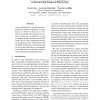Free Online Productivity Tools
i2Speak
i2Symbol
i2OCR
iTex2Img
iWeb2Print
iWeb2Shot
i2Type
iPdf2Split
iPdf2Merge
i2Bopomofo
i2Arabic
i2Style
i2Image
i2PDF
iLatex2Rtf
Sci2ools
NAACL
2007
2007
A Cascaded Machine Learning Approach to Interpreting Temporal Expressions
A new architecture for identifying and interpreting temporal expressions is introduced, in which the large set of complex hand-crafted rules standard in systems for this task is replaced by a series of machine learned classifiers and a much smaller set of context-independent semantic composition rules. Experiments with the TERN 2004 data set demonstrate that overall system performance is comparable to the state-of-the-art, and that normalization performance is particularly good.
Complex Hand-crafted Rules | Computational Linguistics | Data Set Demonstrate | NAACL 2007 | Semantic Composition Rules |
| Added | 30 Oct 2010 |
| Updated | 30 Oct 2010 |
| Type | Conference |
| Year | 2007 |
| Where | NAACL |
| Authors | David Ahn, Joris van Rantwijk, Maarten de Rijke |
Comments (0)

